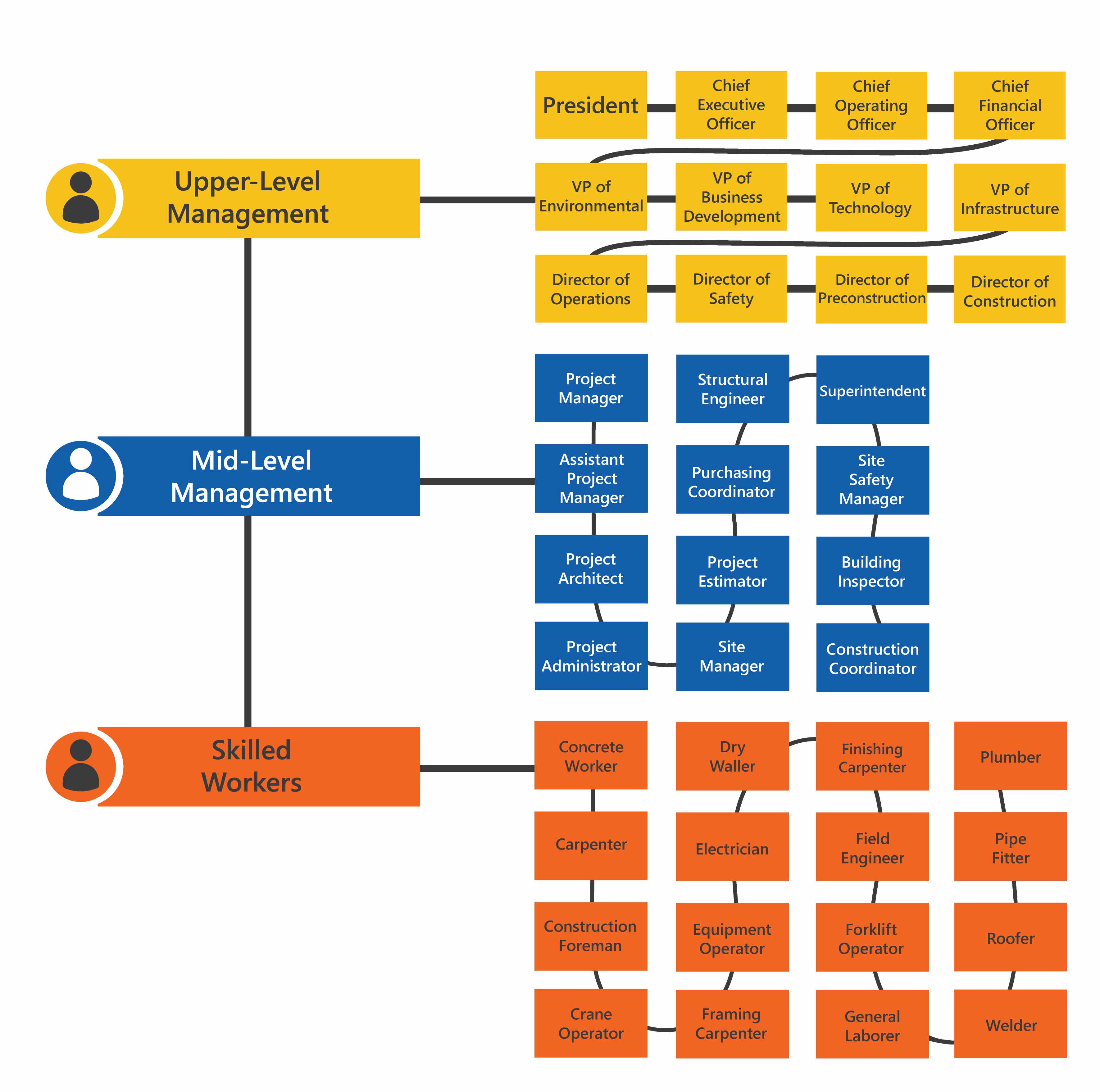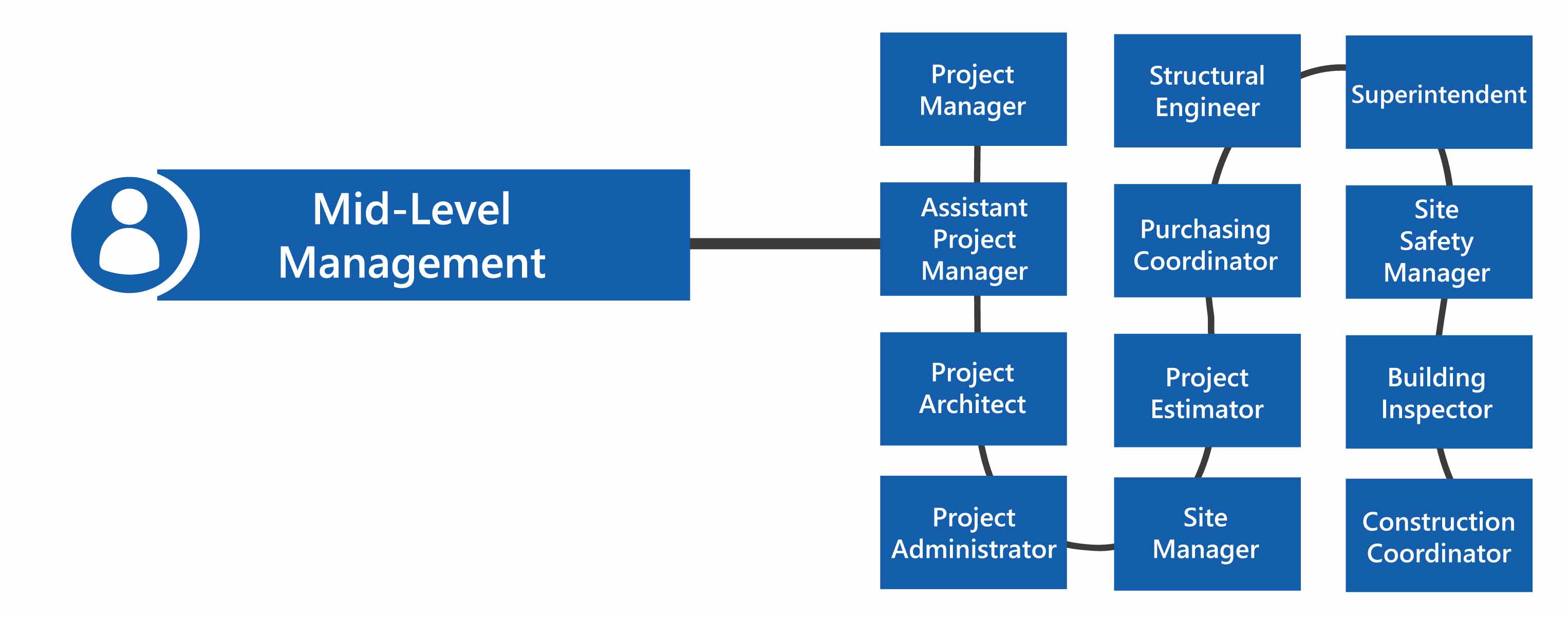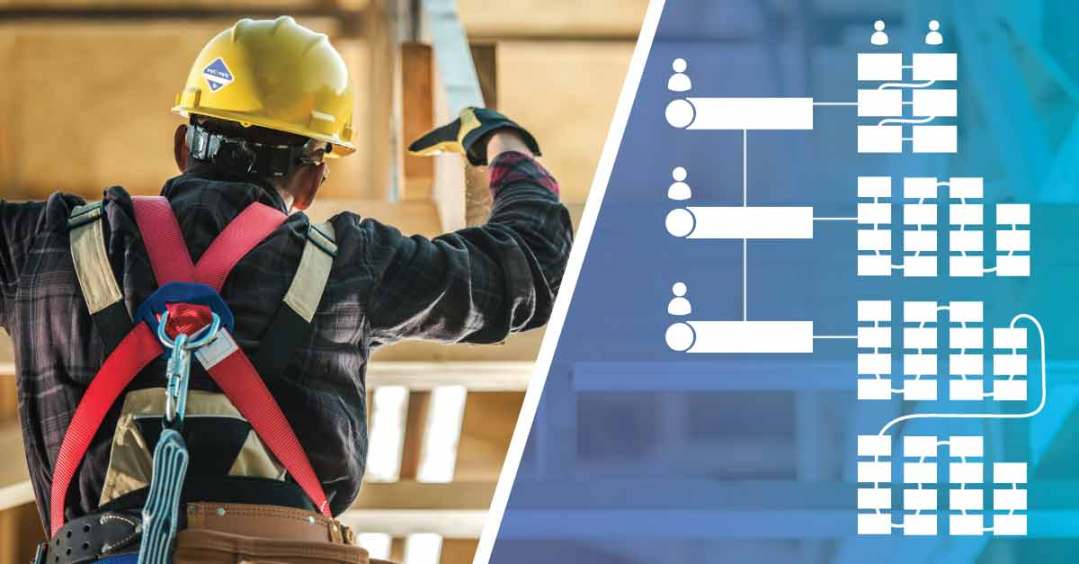How do individuals and/or teams manage construction workers when there may be thousands of workers on large-scale construction projects? Great question.
Well, it’s not an easy task to manage so many moving parts, but the teams and individuals that do manage construction projects have specific tasks keeping each function of a project in proper order. These individuals are vital role players in successfully pulling off a safe, efficient, timely, and cost-effective construction project. Let’s explore the vital teams and leaders that guide a construction project from bid to completion.
Table of Contents
The Construction Hierarchy
a. Upper-Level Management in Construction
b. Mid-Level Management in Construction
c. Skilled Workers in Construction
9 Tips for Managing Construction Workers
1. Remove Obstacles & Barriers
2. Promote a Safe Working Environment
3. Ensure the Worker Understands Project Expectations
4. Assign Admin Staff to Help Onboard the Worker on a Project
5. Introduce Technology That Isn’t Disruptive to Workers
6. Feedback and Recognition to Promote Growth
7. Implement an Effective Site Orientation
8. Reduce Stress & Promote Wellness
9. Celebrate Wins Together
The Construction Hierarchy
Construction projects often have several layers in the hierarchal structure. If you wanted to look at the details of these various layers in the hierarchy, you might say a Project Manager (PM) sits above an Assistant PM or that a journeyperson sits higher than an apprentice. Although these roles are recognized as being at different levels of the food chain, it’s much easier to understand when we break construction workers into just a few similar groups/categories.
Simply put, there are three primary groups of individuals on a project: Upper Management, Middle Management, and Skilled Workers.

Upper-Level Management in Construction

In some cases, individuals with jobs in upper management may not have worked in construction but obtain high levels of education and have experience running efficient businesses. For specific positions, like a Director of Safety, experience managing safety in the field is something that most companies would require. Upper management can often bring together a diverse group of leaders with specific talents and skills to drive business growth. Here are a variety of examples of positions/titles you would see in upper management:
• President
• Chief Executive Officer (CEO)
• Chief Operating Officer (COO)
• Chief Financial Officer (CEO)
• Chief Information Officer (CIO)
• VP of Environmental
• VP of Infrastructure
• VP of Business Development
• VP of Technology
• Director of Safety
• Director of Operations
• Director of Preconstruction
• Director of Construction
The positions listed above are often involved in company-wide decision making that impacts operations on all projects. They are not oblivious to in-field work, but they may not know every detail about a project like a project manager would. The individuals at the top succeed when they listen to their project teams and managers in the field to make informed company-wide decisions.
Example of Collaboration Within an Upper Management Role in the Construction Hierarchy
The Vice President (VP) of Technology suggests the company should adopt new software. This becomes something that all the project teams should expect to adopt/learn, while also providing feedback to the VP of Technology on the adoption process. The Vice President may be influential in the adoption of new technology, but the project teams will also need to find or see clear value in the solution(s) if the technology is to gain widespread company adoption.
Mid-Level Management in Construction

Mid-level managers typically operate at the project level, meaning much of their day-to-day work involves project deliverables that take place either on-site or at the office. Let’s have a look at the positions/titles you might see in a mid-level management role in the construction industry:
• Project Manager
• Assistant Project Manager
• Project Architect
• Project Administrators
• Structural Engineer
• Services Engineer
• Purchasing Coordinator
• Estimator
• Site Manager
• Superintendent
• Site Safety Manager
• Building Inspector
• Construction Coordinator
The positions listed above share an enormous amount of responsibility when it comes to the success of a project but are not necessarily responsible for overall organizational success. These individuals are required to report insights and data back to superiors in the head office.
Example of Collaboration Within a Mid-Level Management Role in the Construction Hierarchy
A Site Safety Manager (SSM) may implement a safety process or procedure on a project that leads to a 70% reduction in incidents over the duration of a project. The success of their safety initiative is something that the SSM reports back to the Director of Safety at the construction firm. The Director of Safety may want to implement this safety process on all construction sites, and the success of one project initiative could become a company-wide standard.
Skilled Workers in Construction

For example, a carpenter, an electrician, and a plumber are all considered skilled workers, but their jobs differ considerably. A carpenter has experience assembling various structures and is required to have knowledge on how to frame and/or apply finishing details. An electrician’s job is to bring power to specific areas on a construction site. A plumber will fit a site with pipe and ensure vital services like water/gas are accessible on-site.
All these roles are unique, but they all require a certain level or set of skills specific to their focus on the construction site. Here are a variety of positions/titles of skilled workers in the trades:
• Carpenter
• Concrete Worker
• Construction Foreman
• Crane Operator
• Dry Waller
• Electrician
• Equipment Operator
• Framing Carpenter
• Finishing Carpenter
• Field Engineer
• Forklift Operator
• General Laborer
• Plumber
• Pipe Fitter
• Roofer
• Welder
Skilled workers put in the labor needed to build all the infrastructure that we see around us. This group of individuals takes direction from project management staff and are typically “head-down” in their approach to getting deliverables completed. A skilled worker thrives in an environment that allows them to perform their job safely and efficiently, something that is controlled by the project teams.
Example of Collaboration Within a Skilled Worker Role in the Construction Hierarchy
A crane operator may have to submit his/her/their tickets to a member of the project management team. Typically, subcontractors and their workers must submit a variety of information during the project onboarding process. Oftentimes, a lot of the admin work or housekeeping tasks might be handled by an administrator within the skilled worker’s organization. It is common for paperwork and admin tasks to be handled by admin teams, while a worker is simply required to submit their documents, get to site, and get their work completed safely/efficiently.
9 Tips for Engaging Construction Workers
If you have hundreds or thousands of workers on a construction site, how do you ensure workers are working safely, efficiently, and remain on track? Well, there are a variety of ways that you can engage your workforce and get the most out of their time on-site.
1. Remove Obstacles & Barriers to Success
A construction worker wants to show up to the site and get to work, simple as that. When a worker gets to the jobsite, they do not want to be stuck jumping through hoops or dealing with administrative tasks in order to start.
Ensure that any of the tasks that might delay a construction worker on their first day on-site, or at the start of a shift, are dealt with prior to arrival. An admin might have to help the worker with the submittal of safety certifications or worker-specific information that is required for the job. Obstacles like training and/or orientations can be arranged and completed before a worker arrives on-site. This will save everyone time and get the worker on-task quicker.
Another frequent barrier to the success of construction workers is when their workspace becomes overly crowded and it prevents them from performing at their best. This phenomenon is known as trade stacking and happens when managers allocate too much labor too quickly on a project.
>>> Trade Stacking in Construction: What It Is and How to Avoid It
2. Promote a Safe Working Environment
Workers will be motivated and excited to work in an environment where they do not feel like their safety is at risk. The most basic way to ensure safe work is performed is to ensure that safety certifications, licenses, and qualifications are up to date. Yes, it might be true that often construction workers overlook safety but that is due to a misalignment in site expectations. If a site or project owner is not making safety a priority, neither will the workers on the site.
It is safe to say all workers want to get home safely at the end of their day on the job. As a manager of construction workers, you need to earn workers’ trust by showing them you care about their wellbeing. Safety is not just a mitigator of risk and protector of a firm’s bottom line, it is an effective motivator for construction workers in today’s construction climate.
>>> Never Send an Untrained or Unqualified Worker to Site Again with CCM
3. Ensure the Worker Understands Project Expectations
If you do not want a worker to make mistakes, increase likelihood of incidents, and overlook basic guidelines, then you MUST ensure a worker understands basic expectations and guidelines. This is an opportunity for the General Contractor (GC) to engage the Subcontractor (sub) and their employees at the start of the project to ensure alignment.
Project teams should be setting clear expectations for all workers on the jobsite. Site-specific orientations can be an effective avenue for setting expectations and verifying a worker’s understanding of the project standards.
4. Assign Admin Staff to Help Onboard the Workforce to a Project
Admin staff are helpful when it comes to onboarding workers and keeping worker documentation organized. Not all construction workers are known for their organizational skills, but their skills on-the-job are what make them the talented professionals that they are. If both the General Contractor and the Subcontractor have admin personnel to help manage worker files and information, the process of sharing information goes that much smoother.
Admin staff can help to ensure a worker is always trained, that they have met site-specific requirements, and send all relevant information to the General Contractor when preparing to start on a project.
5. Introduce Technology That Isn’t Disruptive to Workers
Workers need to focus on their task, not worry about the various technologies being piloted, tested, implemented, or launched on a site. If you are introducing technology on the job, think about how it impacts the workers before you do so. Ideally, a successful use of technology does not impede or interrupt a worker’s ability to be safe and efficient; it should make the job easier and safer. Although skilled workers may not be decision makers when it comes to adoption of technology, their input can be useful on projects.
Technology is emerging at a breakneck pace in construction, so workers should be comfortable with the idea of engaging with technology on a site. However, some construction technology might be beneficial for head office, but it is impeding a worker’s ability to get the job done or creates gross inefficiency at the worker level. Find technology that your field teams and office teams rave about, otherwise it won’t motivate your skilled workers and it could negatively impact project performance.
6. Feedback & Recognition to Promote Growth
Construction firms that view workers as assets or numbers are not the firms that will survive the new age of construction culture. The millennial generation has shown that they need to be engaged and nurtured to succeed on the job. It’s much more than swinging a hammer at a nail.
This means that construction leaders need to ensure that workers are receiving proper recognition for a job well done. Be sure to allow workers to have a voice during and recognize the significance of their opinions/feedback. If possible, coordinate some level of 1-on-1 or performance-related review to show the worker that you are invested in their personal/career development.
7. Implement an Effective Site Orientation
One of the simplest ways to ensure that a construction worker knows the details, expectations, guidelines, and other important project information is from a site-specific orientation. Orientations set the tone for the worker in terms of their involvement in a project. A bad orientation sets misleading, or wrongful expectations, but a strong orientation can foster a motivated individual who works in parallel with the project’s objectives and safety requirements.
Construction orientations no longer require direct face-to-face or classroom-style learning. Although these methods can still be effective, the emergence of new technology allows workers to undertake custom site orientations online and allow GCs to track which workers have completed site orientations. No more wasting time on-site. Ensure that workers are fully onboarded before they arrive and allow them to get to work immediately.
>>> Build, Track, and Administer Customer Online Orientations With New Technology
8. Reduce Stress & Promote Wellness
Workers are engaged when they are comfortable. Stress can be a devastating impairment for a worker and mental distractions can lead to shoddy work or accidents on-site. More contractors are adopting wellness programs and mental health supports for their workers. Ensure that your project teams can identify signs and symptoms of deteriorating mental health and educate everyone on the importance of mental wellness.
If you’re just starting a mental wellness program, invest your time into the various free courses online that speak to the topic of mental health in construction workers. Future Learn, and many other providers offer courses designed to build awareness around mental health in construction.
9. Celebrate Wins Together
Creating new infrastructure and building the world around us is no small achievement. Construction workers and project teams alike should be proud of their builds and celebrate milestones along the way. This keeps the teams involved with the project, excited, and engaged.
In construction, one of the major celebrations is a “Topping Off” ceremony, where the project team and other stakeholders in the project come together to celebrate the placement of the last structural beam. It’s ceremonies and gatherings like this that help foster a close-knit team and, in-turn, boost project morale along the duration of the project.
Conclusion: A Culture of Engagement
The construction hierarchy combines so many individuals with talents, backgrounds, and skills. These diverse, cross-functional groups must work with one another in a way that strengthens the connection between the 3 major levels of the hierarchy. The top construction firms in the world have found a way to build synergies from the head-office down to the workers.
A culture of engagement is not achieved by enacting any one tip listed above, it is formed from a combination of the points. We challenge the construction industry to take these tips and put them into action. If we are missing something that works well for your firm, leave us a note in the comments and we will add it to the list.




Construction workers are at high risk when operating or working around heavy equipment. Heavy equipment hazards include being struck or crushed by equipment and loads that aren’t properly secured.
Construction sites are often chaotic, fast-paced working environments. Large construction projects can have hundreds or even thousands of workers on-site each day.Construction projects often have several layers in the hierarchical structure.